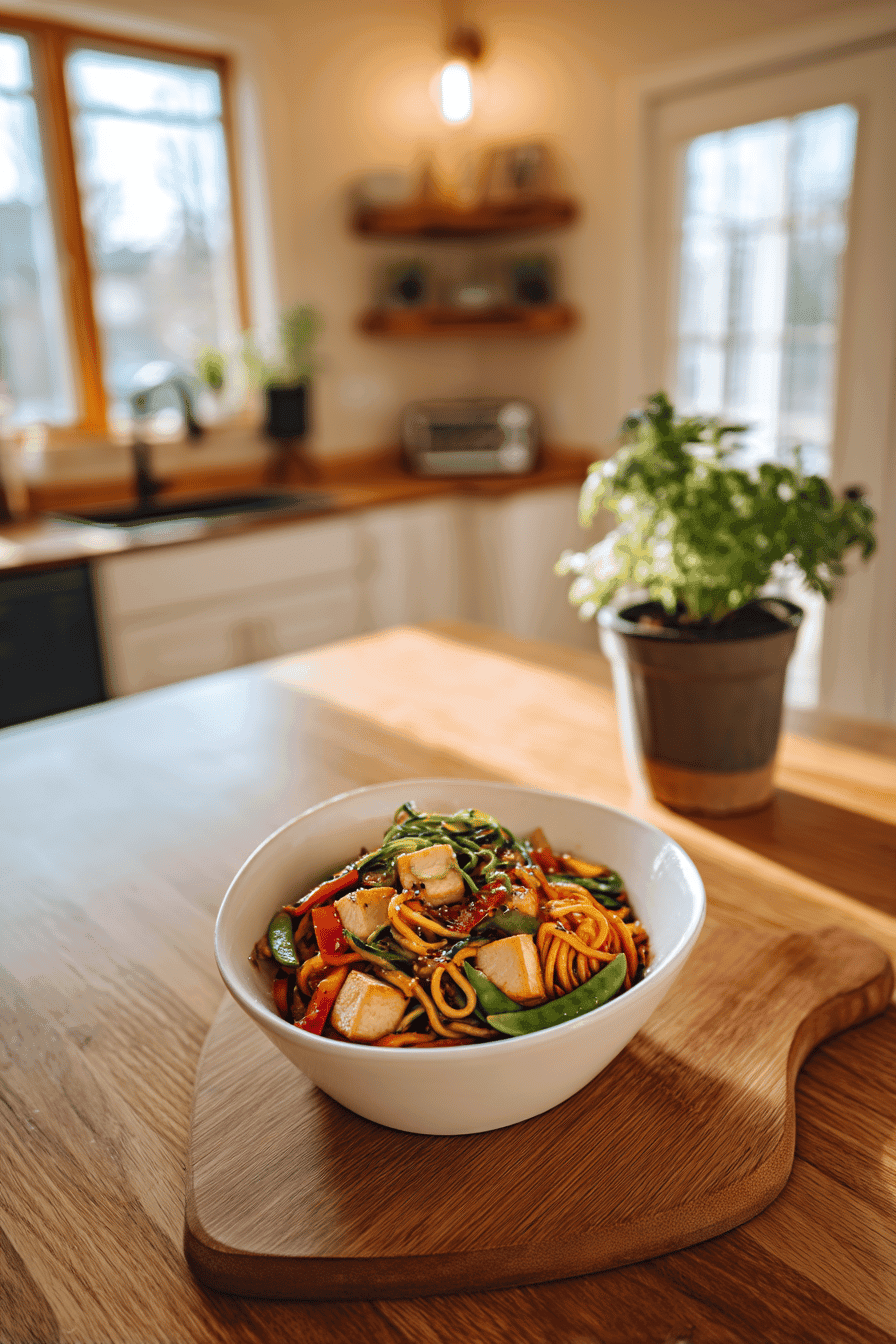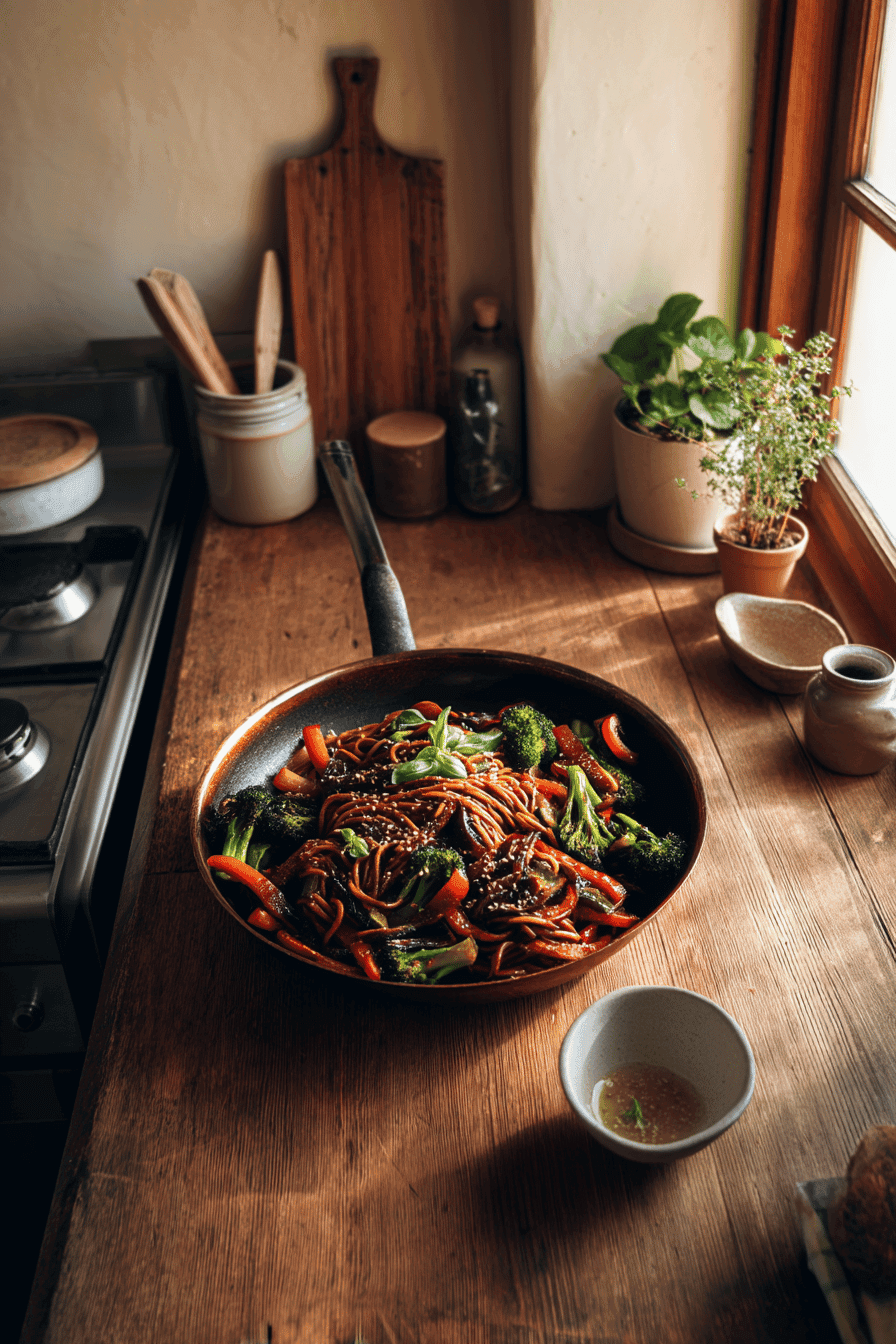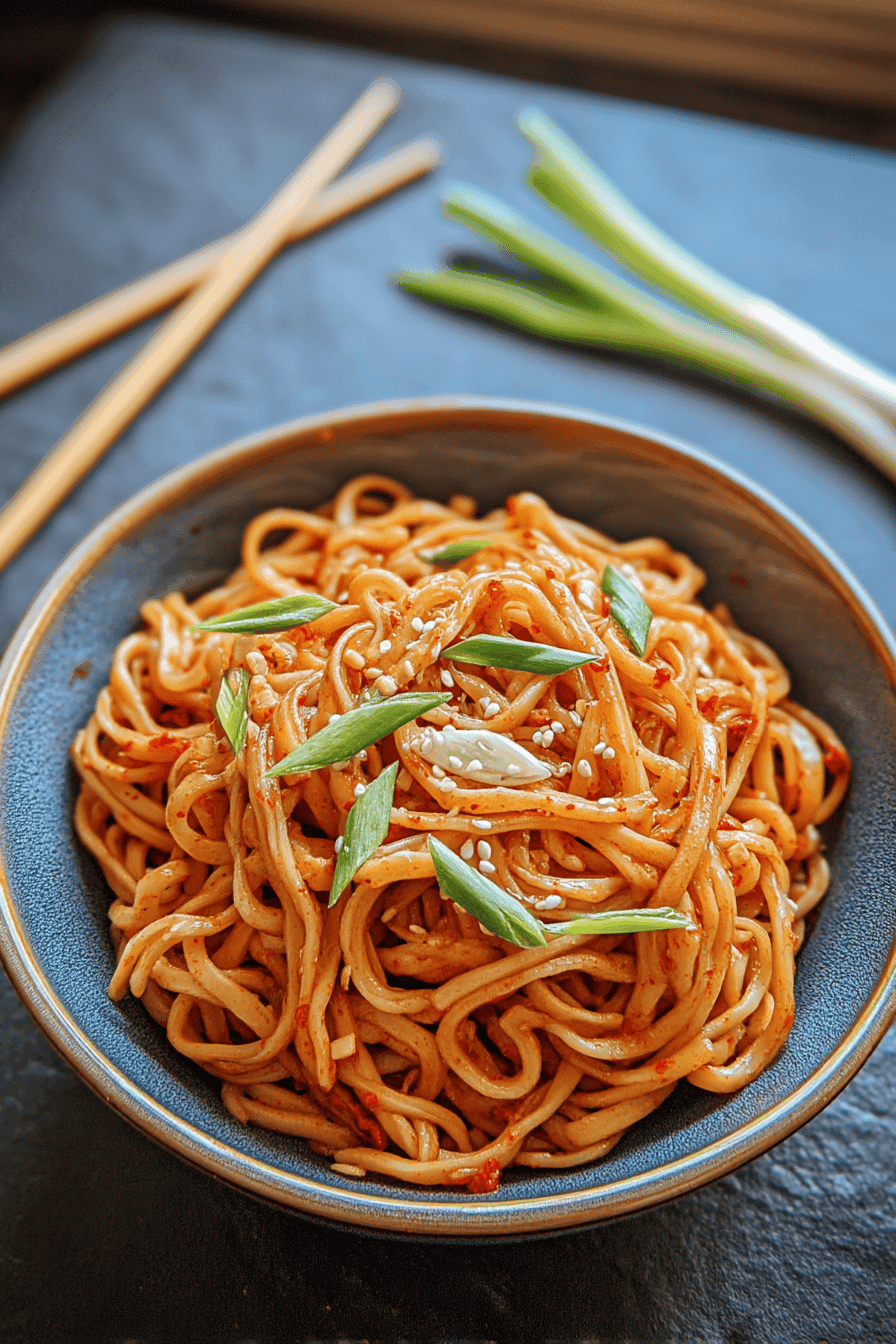Benefits and Advantages of Gochujang Noodles
Gochujang noodles offer a distinctive blend of bold, spicy flavors paired with ease of preparation, making them a favorite for both beginner cooks and seasoned food enthusiasts. The key ingredient, gochujang paste, is a Korean fermented chili paste that delivers complex umami along with a balanced heat that awakens the palate.
From a nutritional perspective, gochujang noodles present a wholesome meal option. This dish typically includes fresh vegetables like napa cabbage, bell peppers, and snap peas, which contribute fiber, vitamins, and antioxidants essential for a healthy diet. Additionally, gochujang itself contains beneficial fermented components that may support gut health, adding an extra layer of wellness to your meal. For those looking to maintain a balanced diet, the recipe manages to offer a good mix of carbohydrates, protein, and healthy fats, especially when enhanced with proteins such as tofu, chicken, or shrimp.
Another advantage is the versatility of gochujang noodles. You can tailor them to suit various dietary needs by substituting noodles or proteins, making this dish inclusive for vegans, gluten-intolerant individuals, or those watching their calorie intake. Plus, it’s a quick dish, usually ready in under 30 minutes, perfect for busy weeknights or potluck gatherings where you want to impress without spending hours in the kitchen.
“This fusion dish balances the richness of spicy, sweet, and savory flavors with nutritional value and flexible preparation methods.”
For more on the health impacts of gochujang, you might find this Health Benefits of Gochujang resource helpful.
Jump to:
- Benefits and Advantages of Gochujang Noodles
- Essential Ingredients for Gochujang Noodles
- Dietary Substitutions to Customize Your Gochujang Noodles
- How to Prepare the Perfect Gochujang Noodles: Step-by-Step Guide
- Step 1: Cook the Noodles
- Step 2: Prepare the Sauce
- Step 3: Sauté Aromatics and Vegetables
- Step 4: Combine Sauce and Noodles
- Step 5: Finish and Serve
- Preparation Timeline
- Mastering Gochujang Noodles: Advanced Tips and Variations
- Balancing Heat and Sweetness
- Roasting and Texture Enhancements
- Experimenting with Noodle Types
- Adding Proteins and More Vegetables
- Rich and Creamy Variation with Gochujang Butter Sauce
- Summary Table: Tips and Variations for Gochujang Noodles
- How to Store Gochujang Noodles: Best Practices
- Refrigeration
- Freezing
- Reheating Tips
- Nutritional Value of Gochujang Noodles
- FAQs: Frequently Asked Questions About Gochujang Noodles
- What is the best type of gochujang to use for gochujang noodles?
- How can I adjust the spiciness level in gochujang noodles?
- What types of noodles work well in gochujang noodles recipes?
- Can I customize gochujang noodles with vegetables or proteins, and how?
- How should I store and reheat leftover gochujang noodles for best taste and safety?
- Spicy Gochujang Butter Noodles Recipe for Authentic Korean Flavor
- Ingredients
- Instructions
- Last Step:
- Notes
- Nutrition
- Did you make this recipe?
Essential Ingredients for Gochujang Noodles
To make the flavorful and authentic gochujang noodles, you will need the following ingredients:
- 16 ounces fresh udon noodles (or 8-9 ounces dried); alternatives: rice noodles, egg noodles, ramen, or spaghetti
- 3 tablespoons gochujang paste (reduce to 2 tablespoons for less heat)
- 1 tablespoon toasted sesame oil (plus extra for drizzling)
- 2 tablespoons soy sauce or tamari (use tamari for gluten-free)
- 2 tablespoons mirin, rice vinegar, or sherry vinegar
- 1 ½ tablespoons brown sugar or honey
- 1 tablespoon gochugaru (optional, for extra chili flavor)
- 1 heaping tablespoon neutral oil or vegetable oil
- 1 bunch scallions (whites and light greens chopped; reserve dark green tops for garnish)
- 4 to 6 garlic cloves, finely chopped
- 1-inch piece fresh ginger, grated or minced
- Vegetables (6 to 8 cups thinly sliced Napa cabbage or 2 medium bell peppers; or mix with snap peas, carrots, bok choy, broccoli)
- ¼ cup roasted white sesame seeds, toasted
- A few handfuls fresh Thai basil leaves or fresh cilantro (optional, recommended for brightness)
- Lime wedges (optional, for serving)
- Salt and pepper to taste
Each element plays a specific role in delivering layers of flavor, texture, and nutrition, from the chewy noodles to the aromatic aromatics and vibrant vegetables.
Toasty sesame seeds are particularly essential and can easily be prepared at home check out this Guide to Using Sesame Seeds in Cooking for tips on perfectly toasting them.

Dietary Substitutions to Customize Your Gochujang Noodles
One of the strengths of gochujang noodles is their adaptability to various diets and taste preferences. Here are some substitution ideas to help you customize the dish:
- Gluten-Free: Swap traditional wheat-based udon noodles with rice noodles, glass noodles, or shirataki noodles. Replace soy sauce with tamari or coconut aminos to keep it gluten-free.
- Vegan: Use plant-based proteins like tofu or tempeh and ensure your gochujang paste contains no animal-derived ingredients, as some varieties include tiny amounts of fermented fish.
- Lower-Calorie: Spiralized vegetables (zucchini, carrots) or shirataki noodles can replace traditional noodles to reduce carbohydrate and calorie content, while adding a fresh texture.
- Less Spicy: Reduce gochujang paste amounts or omit gochugaru to tone down the heat. Incorporate mild elements like coconut milk or a little honey to balance spicy flavors.
- Higher Protein: Add cooked chicken, shrimp, edamame, or extra tofu for a more filling meal, perfect for those seeking more protein.
These substitutions keep the dish vibrant and spicy while ensuring it fits your dietary needs without sacrificing the authentic Korean flavor.
How to Prepare the Perfect Gochujang Noodles: Step-by-Step Guide
Step 1: Cook the Noodles
Begin by boiling 16 ounces of fresh udon noodles according to the package directions, but reduce cooking time by approximately one minute to keep them from becoming soggy. Drain the noodles and reserve some cooking water, which can help loosen the sauce later.
If you prefer gluten-free or vegan options, select rice or glass noodles and follow their respective cooking instructions.
Step 2: Prepare the Sauce
In a mixing bowl, whisk together these ingredients for the gochujang sauce:
- 3 tablespoons gochujang paste
- 1 tablespoon toasted sesame oil
- 2 tablespoons soy sauce or tamari
- 2 tablespoons mirin, rice vinegar, or sherry vinegar
- 1 ½ tablespoons brown sugar or honey
- 1 tablespoon gochugaru (optional)
If the sauce feels too thick, thin it with a few tablespoons of the reserved noodle water for a silky consistency that clings well to the noodles.
Step 3: Sauté Aromatics and Vegetables
Heat 1 heaping tablespoon of neutral or vegetable oil in a large pan or wok over medium-high heat. Add the chopped whites and light greens of 1 bunch of scallions, 4 to 6 finely chopped garlic cloves, and 1-inch grated or minced fresh ginger. Cook for 1–2 minutes until fragrant.
Add roughly 6 to 8 cups of thinly sliced Napa cabbage, or alternatively 2 chopped medium bell peppers, snap peas, carrots, bok choy, or broccoli. Season lightly with salt and pepper. Stir-fry the vegetables for about 3 minutes, or until tender but maintaining some crispness.
Step 4: Combine Sauce and Noodles
Pour the gochujang sauce and ¼ cup toasted white sesame seeds into the pan and let the sauce sizzle briefly to deepen its aroma. Add the cooked noodles and toss thoroughly to coat everything evenly. If the sauce is thick, add more reserved noodle water a tablespoon at a time to achieve the perfect texture and help the sauce stick to the noodles.
Step 5: Finish and Serve
Remove the pan from heat and stir in a few handfuls of fresh Thai basil leaves or cilantro for a burst of brightness. Drizzle extra toasted sesame oil over the noodles. Garnish with the reserved dark green scallion tops and extra sesame seeds.
Serve your gochujang noodles with lime wedges on the side for an optional citrusy twist. This final touch enhances the sweet and spicy balance.
Preparation Timeline
| Step | Approximate Time |
|---|---|
| Prep Ingredients | 15–20 minutes |
| Cook Noodles & Vegetables | 10 minutes |
| Total Time | 20–30 minutes |
This straightforward method ensures success even for first-timers eager to enjoy the savory, spicy goodness of gochujang noodles without fuss.
For those new to cooking udon noodles, you may want to review tips on How to Cook Udon Noodles Perfectly for guidance on texture and timing.

Mastering Gochujang Noodles: Advanced Tips and Variations
Mastering gochujang noodles involves more than just following the recipe; it’s about fine-tuning the flavors and textures to suit your preferences and creating a truly satisfying dish. Here are some detailed tips and variations to help you create an authentic and personalized bowl of gochujang noodles.
Balancing Heat and Sweetness
The key to a great gochujang sauce is balancing its spicy heat with subtle sweetness. You can adjust the heat by reducing the gochujang paste from 3 tablespoons to 2 tablespoons or omit the optional gochugaru if you prefer milder spice. To add sweetness, brown sugar or honey works well, enhancing the umami without overpowering the chili flavor.
Roasting and Texture Enhancements
Roasting your vegetables before adding them to the dish introduces a smoky depth that elevates the flavor. Bell peppers, broccoli, and snap peas can be quickly charred on high heat or roasted in the oven. Toasting the sesame seeds in a dry pan before adding them gives a nutty aroma and crunch, which contrasts delightfully with the soft noodles. Check out this guide to using sesame seeds in cooking for the best results.
Experimenting with Noodle Types
The choice of noodles can dramatically change the character of the dish. Traditional fresh udon noodles provide a thick, chewy bite that holds the sauce well. You can also try dried udon, rice noodles for gluten-free options, ramen for a lighter texture, or even spaghetti for a fusion touch. When using dried noodles, reserve some cooking water to loosen the sauce for better coating. For tips on cooking udon noodles perfectly, you may find this external guide useful.
Adding Proteins and More Vegetables
Boost your gochujang noodles by including proteins such as baked tofu, tempeh, shrimp, or grilled chicken. Marinating tempeh or chicken in a soy-sesame mixture before cooking infuses additional flavors. For vegetables, use a colorful mix like napa cabbage, bell peppers, carrots, snow peas, bok choy, or broccoli to add texture and nutrition. This makes the dish vibrant and satisfying.
Rich and Creamy Variation with Gochujang Butter Sauce
For a richer take, try incorporating unsalted butter (about 6 tablespoons) cooked with garlic before adding the gochujang paste, honey, and vinegar. This creamy sauce pairs wonderfully with spaghetti or ramen noodles, providing a comforting twist on the traditional recipe.
“Mastering these variations allows you to customize the spice, sweetness, and texture to suit your taste, making gochujang noodles your own.”
Summary Table: Tips and Variations for Gochujang Noodles
| Aspect | Tip / Variation | Effect |
|---|---|---|
| Spice Level | Adjust gochujang paste and omit gochugaru | Control heat intensity |
| Sweetness | Add brown sugar or honey | Balances spicy heat |
| Vegetables | Roast before stir-frying | Adds smoky depth and texture |
| Noodles | Try udon, rice, ramen, or spaghetti | Varies chewiness and absorbs sauce |
| Proteins | Add tofu, tempeh, shrimp, chicken | Enhances nutrition & heartiness |
| Rich Variation | Incorporate garlic butter in sauce | Creates creamy, comforting version |
How to Store Gochujang Noodles: Best Practices
Proper storage is essential to maintain the freshness, flavor, and safety of your gochujang noodles after cooking. Follow these guidelines to enjoy your meal later without compromising quality.
Refrigeration
Place leftover gochujang noodles in an airtight container within two hours of cooking to minimize bacterial growth. Store in the refrigerator and consume within 3 to 4 days for optimal taste and food safety.
Freezing
To extend shelf life, freeze portions in freezer-safe containers or resealable bags. Remove as much air as possible to prevent freezer burn. Frozen gochujang noodles can be stored for up to one month. Note that freezing may slightly alter the noodle texture.
Reheating Tips
- Microwave: Heat leftovers covered, adding a splash of water or broth to restore moisture and prevent drying.
- Skillet: Gently warm in a nonstick pan with a little oil or water, stirring frequently for even reheating.
Avoid reheating multiple times as it reduces quality and could pose safety risks. It’s best to reheat only the portion you plan to eat.
“Storing and reheating thoughtfully keeps your gochujang noodles tasting fresh and delicious, even days after cooking.”
Nutritional Value of Gochujang Noodles
Gochujang noodles can be a wholesome and balanced meal featuring key macronutrients and micronutrients. Below, you’ll find an approximate nutritional profile based on a typical serving.
| Nutrient | Amount per Serving | Benefit |
|---|---|---|
| Calories | 354–437 kcal | Provides necessary energy |
| Carbohydrates | 54–69 grams | Main energy source from noodles and vegetables |
| Protein | 10–12 grams | Supports muscle repair and satiety |
| Fats | 12–15 grams | Including healthy unsaturated fats from sesame oil |
| Fiber | 3–8 grams | Promotes digestion and fullness |
| Sodium | 299–895 mg | Balance according to soy sauce/tamari used |
| Vitamin A | 861–1287 IU | Supports vision and immune function |
| Vitamin C | 50–90 mg | Antioxidant and immune support |
With the inclusion of vegetables and protein options, the dish boosts essential vitamins, minerals, and fiber. The fermented gochujang paste may also provide beneficial probiotics that support gut health. For those concerned about sodium intake, using low-sodium soy sauce or tamari helps control salt levels.
You can read more about the health benefits of gochujang to understand why it’s a flavorful and nutritious addition to this recipe.

FAQs: Frequently Asked Questions About Gochujang Noodles
What is the best type of gochujang to use for gochujang noodles?
How can I adjust the spiciness level in gochujang noodles?
What types of noodles work well in gochujang noodles recipes?
Can I customize gochujang noodles with vegetables or proteins, and how?
How should I store and reheat leftover gochujang noodles for best taste and safety?

Spicy Gochujang Butter Noodles Recipe for Authentic Korean Flavor
🍜 This spicy Gochujang Butter Noodles recipe is a delightful fusion of sweet, savory, and umami flavors, perfect for a satisfying meal any day of the week.
🌶️ Experience authentic Korean flavors with this adaptable dish, ideal for both adventurous food lovers and those seeking a quick dinner fix.
- Total Time: 20-30 minutes
- Yield: 3–4 servings 1x
Ingredients
16 ounces fresh udon noodles (or 8–9 ounces dried, or substitute with rice noodles, egg noodles, ramen, or spaghetti)
3 tablespoons gochujang paste (adjust to 2 tablespoons for less heat)
1 tablespoon toasted sesame oil (plus extra for drizzling)
2 tablespoons soy sauce or tamari (for gluten-free)
2 tablespoons mirin, rice vinegar, or sherry vinegar
1 ½ tablespoons brown sugar or honey
1 tablespoon gochugaru (optional for extra chili flavor)
1 heaping tablespoon neutral oil or vegetable oil
1 bunch scallions (whites and light greens chopped; reserve dark green tops for garnish)
4 to 6 garlic cloves, finely chopped
1-inch piece fresh ginger, grated or minced
6 to 8 cups thinly sliced Napa cabbage or 2 medium bell peppers, or a mix with snap peas, carrots, bok choy, broccoli
¼ cup roasted white sesame seeds, toasted
A few handfuls fresh Thai basil leaves or fresh cilantro (optional, but recommended for brightness)
Lime wedges (optional, for serving)
Salt and pepper to taste
Instructions
1. Cook noodles: Prepare noodles according to package instructions but reduce cooking time by about one minute to avoid sogginess. Reserve some cooking water before draining.
2. Make sauce: Whisk together gochujang paste, toasted sesame oil, soy sauce or tamari, mirin or vinegar, brown sugar or honey, and gochugaru if using. If the sauce is too thick, thin with a few tablespoons of reserved noodle water.
3. Sauté aromatics and vegetables: Heat neutral oil in a large pan or wok over medium-high heat. Add scallion whites, garlic, and ginger; cook for 1–2 minutes until fragrant. Add bell peppers (if using) and cook briefly. Then add Napa cabbage or other chosen vegetables; season with salt and pepper and stir-fry for about 3 minutes until tender but still crisp.
4. Combine noodles and sauce: Add the gochujang sauce and toasted sesame seeds to the pan, letting it sizzle briefly. Add cooked noodles and toss thoroughly to coat. Add reserved noodle water as needed to loosen the sauce and help it cling to noodles.
5. Finish and serve: Remove from heat, stir in fresh Thai basil or cilantro, and drizzle with toasted sesame oil. Garnish with reserved scallion tops and additional sesame seeds. Serve with optional lime wedges on the side.
Last Step:
Please leave a rating and comment letting us know how you liked this recipe! This helps our business to thrive and continue providing free, high-quality recipes for you.Notes
🍜 Use fresh or frozen udon noodles for the best texture; dried noodles can be substituted but adjust quantity and use reserved cooking water to loosen sauce.
🥄 Toast sesame seeds in a dry pan before adding for enhanced flavor.
🥦 Customize vegetables based on availability and preference—try snap peas, carrots, broccoli, or baby bok choy.
- Prep Time: 15-20 minutes
- Total: 20-30 minutes
- Cook Time: 10 minutes
- Category: Main Course
- Method: Stovetop
- Cuisine: Korean
- Diet: Vegetarian
Nutrition
- Serving Size: 1 plate
- Calories: 354-437 kcal
- Sugar: 8-22 g
- Sodium: 299-895 mg
- Fat: 12-15 g
- Saturated Fat: value unavailable
- Unsaturated Fat: value unavailable
- Trans Fat: value unavailable
- Carbohydrates: 54-69 g
- Fiber: 3-8 g
- Protein: 10-12 g
- Cholesterol: value unavailable







